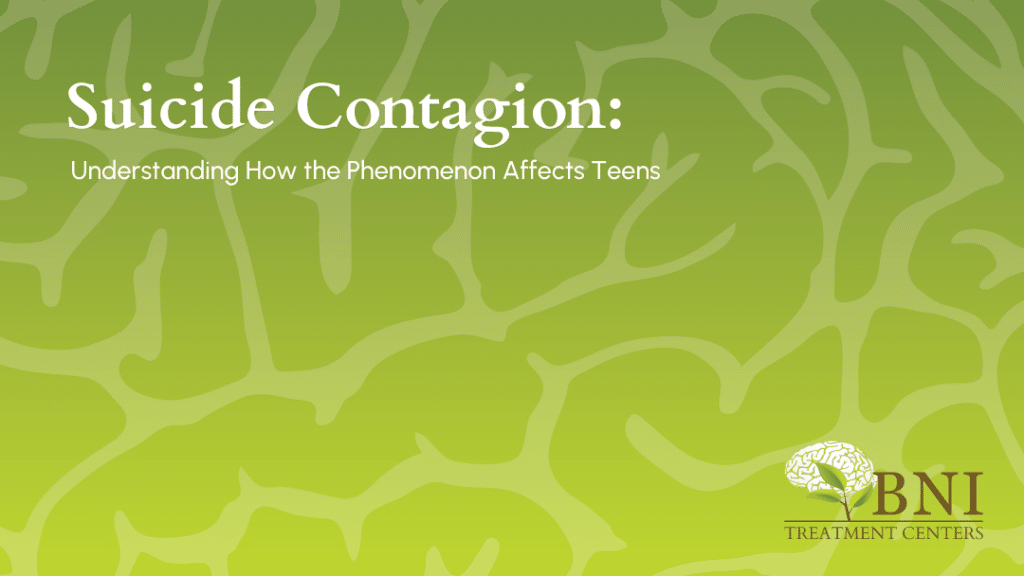
Suicide contagion refers to a phenomenon in which a death by suicide happens, and those who knew the person begin to self-harm, have thoughts of suicide, or plan to die by suicide themselves. This can occur due to the death of a loved one, a famous celebrity, or other media influence.
Teens are especially impressionable when it comes to suicide. The rate of suicides in California in 2023 was 8.9 per 100,000 residents ages 15-24. This shows the need for adolescent mental health care in our communities, as suicide is a highly preventable death.
At BNI Treatment Centers, we understand this need, which is why our psychiatrist-led facility offers mental health and substance use disorder treatment for teens. Our blog serves as a free resource for parents and professionals looking to learn more about adolescent mental health concerns. In this article, we will be discussing suicide contagion and how parents can help their teen heal.
Suicide Contagion: Definition, Dynamics, and Impact
Suicide contagion is a phenomenon well-documented in psychological and sociological literature. The term refers to an increase in suicidal behaviors in individuals who have been exposed to a death by suicide of a friend or loved one. Suicide contagion does not just include dying by suicide – the person may also engage in self-harm or experience suicidal ideation. When 3 or more deaths by suicide occur within a 7 to 10 day period in a singular community (school, workplace, etc.), it is referred to as a suicide cluster.
The history of suicide contagion dates back to the 1700s. A German author, Johann Wolfgang von Goethe, wrote a novel titled “The Sorrows of Young Werther.” It described a man experiencing unrequited love and therefore dying by suicide. After publication, the suicide rate in various European countries increased, giving suicide contagion the name “the Werther effect.”
The impact of suicide contagion is significant, particularly in close-knit communities and among vulnerable populations. This is especially true for adolescents as their developing minds are increasingly impressionable. Clusters of adolescent suicides have been reported in various countries, suggesting that social and emotional connections between individuals play a key role in this phenomenon. Understanding suicide contagion is critical to developing effective preventive strategies and interventions tailored to at-risk groups.

Identifying Risk Factors Associated with Suicide Contagion
Understanding the risk factors of suicide contagion is essential for proactive intervention and prevention efforts. These risk factors are multifaceted, encompassing psychological, social, and environmental domains.
Psychological risk factors stem strongly from the presence of mental health disorders, particularly depression, anxiety, and bipolar disorder. Adolescents with a history of suicidal ideation or attempts are especially vulnerable. Psychological distress can heighten susceptibility to imitation after exposure to another person’s suicide, particularly when coping skills and compassionate support are lacking.
Social risk factors are equally significant. Adolescents experiencing bullying, family stress, or social isolation are at heightened risk. Peer relationships exert a powerful influence during adolescence. When a peer dies by suicide, surviving adolescents may closely identify with the deceased, see suicide as a viable coping strategy, or experience intense grief that exacerbates their vulnerabilities.
Media exposure represents a critical environmental risk factor. Studies have found that sensationalized or detailed reporting of suicide cases can increase the risk of contagion. Adolescent internet searches surrounding suicide increased 19% after the series premiere of the Netflix series “13 Reasons Why.” Certain phrases, such as “how to commit suicide,” rose 26%, while “how to kill yourself” increased by 9%, and “commit suicide” by 18%. However, other studies have found that media exposure can also have a positive effect, with adolescents seeing content for suicide prevention options and crisis management.
Additionally, certain demographic characteristics can elevate risk. Studies indicate that LGBTQ+ adolescents, who often face increased discrimination and mental health challenges, are more vulnerable to suicide contagion. Similarly, adolescents living in communities with limited access to mental health care resources are at a greater risk due to the lack of timely support systems.
The Importance of Communicating with Adolescents Following a Suicide Event
Effective communication with adolescents following a suicide event is critical to promoting healing, providing support, and preventing further risk of suicide contagion. Approaches must be characterized by sensitivity, openness, and validation of emotions.
Creating a safe environment where adolescents feel comfortable expressing their feelings without fear of judgment is imperative. Open-ended questions and active listening techniques allow young individuals to articulate their thoughts and emotions. It is important to acknowledge the reality of the loss, rather than hiding emotions in secret. Adolescents are often perceptive and may react negatively when faced with the true details of the event. Age-appropriate, honest communication is crucial to build trust and helps prevent misinformation from spreading within peer groups.
While parents provide the first line of communication after a tragic death by suicide, it is important for the teen to talk to other sources. Counselors and mental health professionals can provide deeper insight and help with managing negative feelings. Attending support groups for grief will build connections with fellow peers and promote ongoing communication.
Evidence-Based Strategies to Mitigate Adolescent Suicide Risk
A range of evidence-based strategies has been developed to mitigate adolescent suicide risk, particularly in the context of preventing contagion effects. These include both family and professional involvement.
- Prescreening: Screening tools are utilized to properly assess the risk of suicide and understand how adolescents are feeling in the moment. Continued screening by mental health professionals is a vital process in continued suicide prevention.
- Talk therapy: Cognitive behavioral therapy (CBT) and dialectical behavior therapy (DBT) are among the most effective treatments. These therapies focus on developing emotional regulation, distress tolerance, and problem-solving skills. DBT for adolescents specifically emphasizes life skills to counteract suicidal ideation.
- Training programs: Initiatives such as Question, Persuade, Refer (QPR) prepare parents and school professionals to recognize warning signs of suicide and respond effectively.
- Reduction methods: Parents can take measures to reduce access to methods for suicide, such as securing firearms, monitoring medication access, and implementing parental controls for internet access reduces the risk during impulsive suicidal crises.
- Parental involvement: Encouraging open communication about emotions and mental health within the family significantly reduces suicide risk. Parental involvement in adolescents’ lives is crucial for a positive and supportive environment.
- Crisis management resources: In the case of a mental health crisis, parents need to be ready with resources for their teens. 988 is the national suicide hotline and connects adolescents to resources in the area or provides a safe space just to talk. It is accessible via call, text, and chat.

Mental Health Help for Teens at BNI Treatment Centers
Having a close friend or family member die by suicide is tragic and can have a severe impact on your teen’s mental health. They may need additional support to lean on as they grieve and navigate life through the loss or their own suicidal ideation treatment. Mental health treatment for teens is available for this reason and will provide a safe space for your teen to begin healing. Through guided therapy, peer support groups, and coping skill development, your teen will have the tools necessary to continue through life with a positive mind.
If your teen is expressing mental health concerns or even thoughts of suicide, help is available right now. BNI Treatment Centers has been serving the Los Angeles area, providing quality mental health care for teens ages 10-18. Our dedicated team is psychiatrist-led and offers stabilization services during crisis moments as well as inpatient and outpatient treatment options. Call us today at (888) 522-1504 to learn more about our program offerings.
BNI Treatment Centers: Science-based, evidence-backed, compassion-led.




